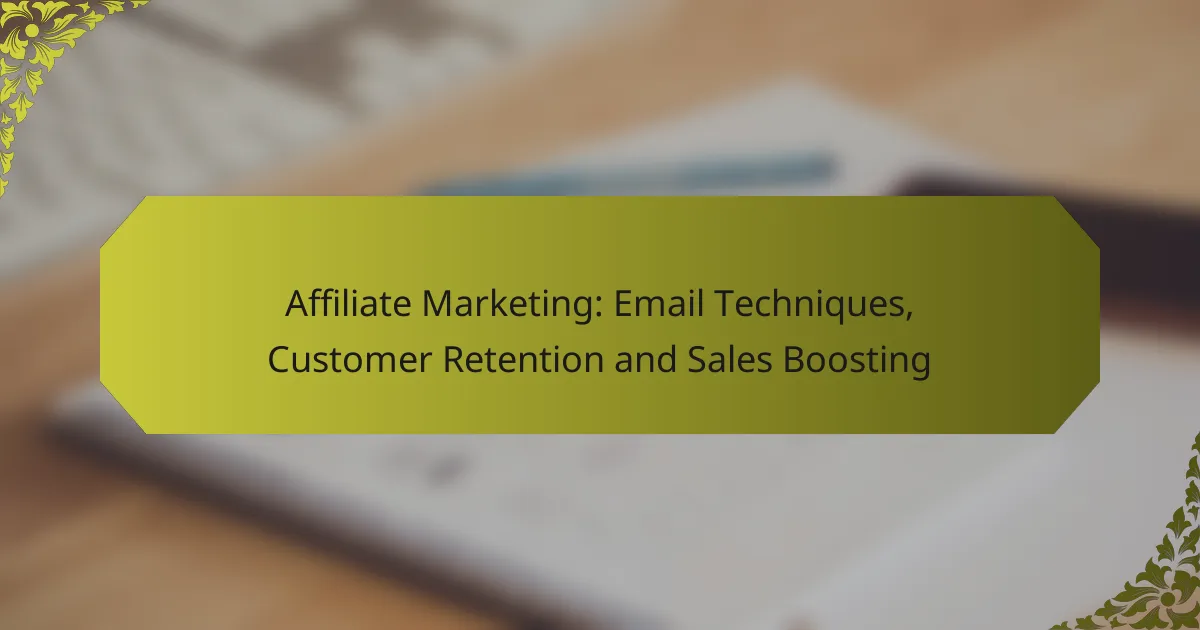In affiliate marketing, the design and functionality of landing pages play a crucial role in driving conversions and enhancing user experience. By implementing effective calls-to-action, optimizing for mobile devices, and ensuring fast load times, marketers can significantly improve their conversion rates. Focusing on user engagement through relevant content and high-quality visuals further helps in guiding visitors towards desired actions, ultimately boosting revenue for affiliates.

How to optimize landing pages for affiliate marketing?
To optimize landing pages for affiliate marketing, focus on enhancing user experience, increasing conversion rates, and clearly guiding visitors towards desired actions. Key strategies include using effective calls-to-action, conducting A/B testing, ensuring mobile responsiveness, utilizing high-quality visuals, and incorporating testimonials.
Use clear calls-to-action
Clear calls-to-action (CTAs) are essential for guiding users toward taking specific actions, such as making a purchase or signing up for a newsletter. Use strong, action-oriented language and ensure that CTAs stand out visually on the page. For example, buttons like “Buy Now” or “Get Started” should be prominently placed and easily accessible.
Consider using contrasting colors for your CTAs to make them more noticeable. A/B testing different phrases and placements can help determine which CTAs yield the best conversion rates.
Implement A/B testing
A/B testing involves comparing two versions of a landing page to see which one performs better in terms of user engagement and conversion rates. This method allows you to make data-driven decisions about design elements, content, and CTAs. Start by changing one variable at a time, such as the headline or image, to isolate its impact.
Track key metrics like click-through rates and conversion rates to evaluate the effectiveness of each version. Aim for a statistically significant sample size to ensure reliable results before implementing changes site-wide.
Enhance mobile responsiveness
With a significant portion of traffic coming from mobile devices, ensuring your landing pages are mobile-responsive is crucial. A mobile-responsive design adjusts seamlessly to different screen sizes, providing an optimal viewing experience. This includes using larger fonts, touch-friendly buttons, and streamlined navigation.
Test your landing pages on various devices and browsers to identify any issues. Tools like Google’s Mobile-Friendly Test can help assess your page’s responsiveness and suggest improvements.
Utilize high-quality visuals
High-quality visuals, including images and videos, can significantly enhance the appeal of your landing pages. Use relevant images that support your message and resonate with your target audience. Avoid stock photos that feel generic; instead, opt for authentic visuals that reflect your brand’s identity.
Consider including videos that explain your product or service, as they can increase engagement and conversion rates. Ensure that all visuals are optimized for fast loading to prevent user drop-off.
Incorporate testimonials and reviews
Incorporating testimonials and reviews can build trust and credibility with potential customers. Displaying positive feedback from previous users can alleviate concerns and encourage new visitors to take action. Use real names and photos (with permission) to enhance authenticity.
Consider creating a dedicated section for testimonials or integrating them throughout the landing page. Highlighting specific benefits that users have experienced can make your offer more compelling and relatable.

What is the impact of conversion rates on affiliate marketing?
Conversion rates significantly influence affiliate marketing by determining how effectively traffic is turned into sales. Higher conversion rates lead to increased revenue for affiliates, reflecting the overall effectiveness of marketing strategies and user engagement.
Higher conversion rates increase revenue
When conversion rates rise, affiliates earn more revenue from their marketing efforts. For example, if an affiliate promotes a product with a 5% conversion rate and drives 1,000 visitors, they can expect 50 sales. If they improve that rate to 10%, the same traffic could yield 100 sales, effectively doubling their income.
To boost conversion rates, affiliates should focus on optimizing landing pages, improving call-to-action visibility, and ensuring that the content aligns with user intent. Small adjustments can lead to significant revenue increases.
Conversion rates reflect user engagement
Conversion rates serve as a key indicator of user engagement with the content. A high conversion rate suggests that visitors find the offer appealing and relevant, while a low rate may indicate a disconnect between the audience and the marketing message.
To enhance user engagement, affiliates should analyze user behavior through tools like heatmaps and A/B testing. Understanding what resonates with the audience can help refine marketing strategies and improve conversion rates.
Improved rates enhance affiliate partnerships
Affiliates with higher conversion rates are often more attractive to potential partners. Brands and advertisers look for affiliates who can effectively convert traffic into sales, as this directly impacts their bottom line.
To strengthen partnerships, affiliates should showcase their conversion metrics and demonstrate successful campaigns. Building a reputation for high conversion rates can lead to better commission structures and exclusive offers from brands.

How to improve user experience on affiliate landing pages?
Improving user experience on affiliate landing pages involves optimizing navigation, reducing load times, and ensuring content relevance. These factors significantly influence how visitors interact with the page and can lead to higher conversion rates.
Streamline navigation
Streamlined navigation helps users find what they need quickly, reducing frustration and increasing the likelihood of conversion. Keep the menu simple, with clear labels and a logical structure that guides users through the site.
Consider using a sticky navigation bar that remains visible as users scroll. This allows easy access to important sections without having to scroll back up. Avoid cluttering the navigation with too many options; aim for a handful of key categories.
Reduce page load times
Page load times are critical for user retention; slow-loading pages can lead to high bounce rates. Aim for load times under two seconds, as studies show that even a one-second delay can reduce conversions significantly.
To improve load times, optimize images and use efficient coding practices. Tools like Google PageSpeed Insights can help identify issues. Consider using a content delivery network (CDN) to serve content more quickly to users across different regions.
Ensure content relevance
Content relevance directly impacts user engagement and conversion rates. Ensure that the content on your landing page aligns with the expectations set by your marketing efforts, such as ads or email campaigns.
Use clear, concise language and focus on the benefits of the products or services offered. Regularly update content to reflect current trends and user interests, and consider A/B testing different headlines or calls to action to see what resonates best with your audience.

What metrics should be tracked for landing page performance?
To effectively assess landing page performance, focus on key metrics such as bounce rates, click-through rates, and user session duration. These metrics provide insights into user engagement and the overall effectiveness of your landing page in converting visitors.
Monitor bounce rates
Bounce rate measures the percentage of visitors who leave your landing page without interacting further. A high bounce rate, typically above 50%, may indicate that your content is not resonating with users or that the page is not meeting their expectations.
To improve bounce rates, ensure that your landing page has a clear value proposition and engaging content. Consider A/B testing different headlines or layouts to see what keeps visitors engaged longer.
Track click-through rates
Click-through rate (CTR) indicates the percentage of visitors who click on a specific link or call-to-action (CTA) on your landing page. A higher CTR suggests that your CTAs are compelling and relevant to your audience.
To optimize CTR, use action-oriented language in your CTAs and ensure they are prominently placed. Aim for a CTR of at least 2-5% as a benchmark, but adjust expectations based on your industry and audience.
Analyze user session duration
User session duration measures how long visitors stay on your landing page. Longer session durations often correlate with higher engagement and interest in your content. Aim for an average session duration of at least 1-2 minutes.
To increase session duration, provide valuable and relevant content that encourages users to explore further. Incorporate multimedia elements like videos or infographics to keep users engaged and reduce the likelihood of them leaving quickly.

What are the best practices for affiliate marketing landing pages?
The best practices for affiliate marketing landing pages focus on optimizing user experience and increasing conversion rates. Key elements include understanding your audience, implementing effective SEO strategies, and ensuring a clear call to action.
Focus on targeted audience
Identifying and understanding your targeted audience is crucial for creating effective landing pages. Tailor your content, design, and offers to meet the specific needs and preferences of your audience segment.
Utilize demographic data, interests, and online behavior to create personas that guide your landing page development. This ensures that the messaging resonates and encourages visitors to take action.
Utilize SEO strategies
Incorporating SEO strategies into your landing pages enhances visibility and attracts organic traffic. Focus on relevant keywords that your audience is likely to search for and integrate them naturally into your content.
Optimize on-page elements such as title tags, meta descriptions, and headers to improve search engine rankings. Additionally, ensure that your landing page loads quickly and is mobile-friendly, as these factors significantly impact user experience and search performance.



